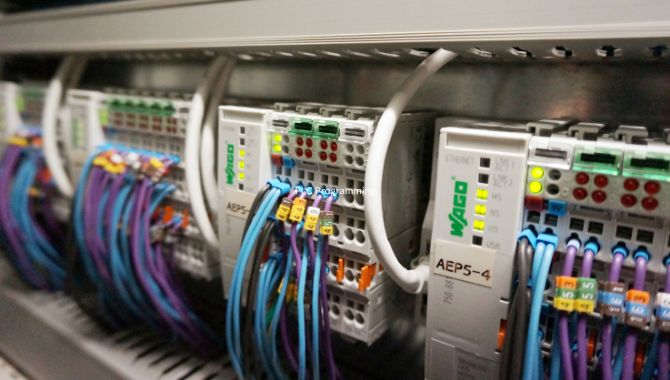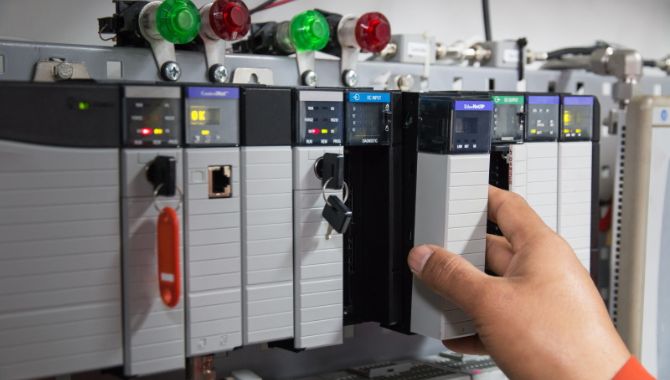PLC (Programmable Logic Controller) programming is fundamental in industrial automation. These robust, industrial-grade computers are designed to perform automation tasks in manufacturing and production settings. Understanding PLC programming involves learning how to effectively instruct these devices to control machines, processes, and entire production lines.
What is a PLC?
A PLC is a type of digital computer used for the automation of electromechanical processes, such as control of machinery on factory assembly lines, amusement rides, or light fixtures. Unlike general-purpose computers, the PLC is designed for multiple inputs and output arrangements, extended temperature ranges, electrical noise immunity, and vibration and impact resistance.
Key Components of a PLC
- Central Processing Unit (CPU): The brain of the PLC, responsible for interpreting and executing program instructions.
- Power Supply: Provides the necessary power for the PLC to operate.
- Input/Output (I/O) Modules: Interface between the PLC and the machinery, sensors, and actuators.
- Programming Device: Used to input the desired instructions into the PLC. This could be a computer with appropriate software.
Types of PLC Programming Languages
- Ladder Logic: Resembling electrical relay logic diagrams, it’s the most popular and widely used language in PLC programming.
- Function Block Diagram (FBD): Uses blocks to represent functions, making it easier to visualize complex processes.
- Structured Text (ST): A high-level textual language resembling Pascal or C, suitable for complex mathematical functions.
- Sequential Function Charts (SFC): Used for structuring the internal organization of a program.
- Instruction List (IL): A low-level textual language similar to assembly language.
Basic Concepts in PLC Programming
- Scan Cycle: PLCs operate cyclically, continuously scanning the program from start to end, processing inputs, executing the logic, and updating outputs.
- Boolean Logic: The fundamental building block in PLC programming, using AND, OR, NOT, NAND, and NOR operations.
- Timers and Counters: Used to create delays and count events, essential for managing processes that are dependent on time or repetitive occurrences.
- Data Handling: Managing data through registers, memory locations, and data blocks for efficient operation.
- Analog Processing: Handling analog signals for processes requiring variable control, such as temperature or pressure.
Programming a PLC: Steps and Considerations
- Define Objectives and Requirements: Clearly outline what the automation system needs to achieve.
- Develop a Program Structure: Plan the program structure, considering future scalability and maintainability.
- Write the Program: Using the selected programming language, write the instructions that will control the PLC.
- Test and Debug: Thoroughly test the program to identify and fix any issues before deployment.
- Documentation: Keep detailed records of the program, including flowcharts, diagrams, and comments within the code for future reference and troubleshooting.
Advanced PLC Programming Techniques
- Modular Programming: Breaking down the program into smaller, reusable modules or subroutines enhances readability and maintainability.
- PID Control: Implementing Proportional-Integral-Derivative (PID) controllers for precise control of processes.
- Networking and Communication: Enabling PLCs to communicate with other PLCs, computers, and control systems using various communication protocols like Ethernet/IP, Modbus, and Profibus.
- HMI Integration: Connecting PLCs to Human-Machine Interfaces (HMIs) for better control and visualization of processes.
- Safety and Redundancy: Incorporating safety functions and redundant systems to ensure reliable and safe operation of the automation system.
Applications of PLC Programming
- Manufacturing: Automating assembly lines, robotic devices, and machine tools.
- Process Control: Managing processes in industries like oil and gas, water treatment, and chemical production.
- Building Automation: Controlling lighting, HVAC systems, and security systems.
- Material Handling: Automating conveyor systems, sorting machines, and storage systems.
- Energy Management: Optimizing energy usage in industrial plants and smart grids.
Conclusion
PLC programming is a critical skill in the industrial automation sector, offering precision, efficiency, and control over various processes and machinery. Mastery of different PLC programming languages and advanced techniques can lead to significant improvements in productivity and reliability in automated systems. Whether you are a seasoned engineer or a newcomer to the field, understanding the intricacies of PLC programming is essential for designing, implementing, and maintaining robust automation solutions.
As technology evolves, staying updated with the latest advancements in PLC programming and applications will ensure you remain at the forefront of industrial automation. Swastika, a leader in providing cutting-edge industrial solutions, recognizes the importance of skilled PLC programmers in driving innovation and efficiency in the industry. By partnering with experts in PLC programming, Swastika continues to deliver top-notch automation services that meet the highest standards of quality and performance.


